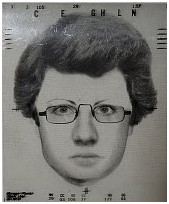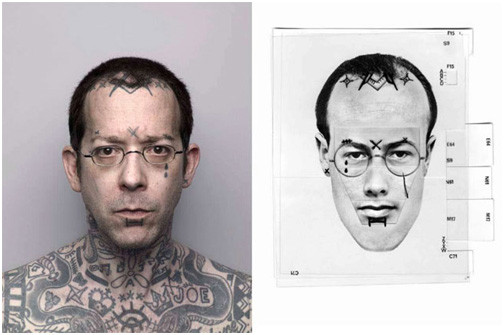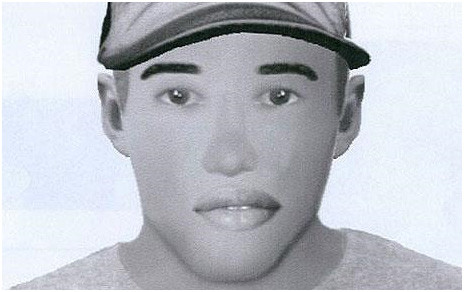Interviewing Witnesses
Recognising Faces
According to Loftus, we recall faces from stereotypical ideas that we have known as schemas.
The facial composite technique assists witnesses in putting together the face of the criminal.

Identikit used in 1940's

Photofit used in UK

.E-Fit created from a Database of faces
Some prefer to employ artists who draw an impression of the offender. This is a gestalt approach that looks at the face as a whole rather than separate parts.
Bruce's (1999) experiment on face recognition are shown below;
First experiment; Bruce used 30 staff and students and after taking photographs of 10celebrities and created 40 facial composites. Some of the participants were showed only external features (ears, shape of head, hair) and some were only shown internal features (eyes, nose, mouth) and some were shown entire composites. The participants needed to match the composite to the original photograph. Participants matched correctly 35% of the time using full or external composites but only about 19% of the time with just the internal features.
Second Experiment; This was similar to the first but the celebrities either looked like each other or they didn’t. This time participants matched correctly 42% of the time with external features but only 24% for the internal features.
Therefore, according to Bruce’s experiments we prefer the larger external features to help us to recall faces
Variables affecting identification
- Whether you have a good or poor memory
- Stress and emotion
- The length of time ago that you saw the face you are trying to recall
- Your recall ability if the context is different
- How meaningful the face is to you
Concentrate on the picture below for 30 seconds and then try to recall as much as you can from the picture such as clothes, colours, windows, etc

Now do the same with this picture...

Could you recall more with the second picture?
Loftus’ (1987) did a lab experiment on weapon focus and found that witnesses have difficulty recalling details of a scene of a crime and features of the offender when there is a weapon involved.
Witnesses have difficulty recalling details when a weapon is involved because of arousal. We are distracted by the presence of a weapon and therefore don’t notice other important details such as the perpetrators face.
Pickel (1999) asserts it is to do with our schemas. If we see, for example, guns at a rifle range, then we will recall more. It is because we aren’t used to seeing a gun or a knife in a shop, for example, and are therefore distracted by it.
The Cognitive Interview
Geiselman and Fisher (1992) developed the Cognitive Interview as police interviews were found to be ineffective when interviewing witnesses. This interview was based on memory theories such as schemas, certain cues and contextual and emotional cues.
|
Context Reinstatement Define; To recreate the scene in the mind of the witness; smells, sights and sounds as well as emotion
|
Why this works To revisit the scene jogs the memory Evidence suggests we are more likely to remember if in a similar context |
|
Focus retrieval; Define; report everything, even trivial details |
Why this works This helps in terms of mental reconstruction of the scene and any clue could be important |
|
Extensive retrieval; Define; focusing on empathy; witnesses place themselves in the position of other victims or witnesses |
Why this works The change of perspective reduces the chance of false recall as a result of schemas that we often naturally put in place |
|
Change order; Define; recall events in a different/unusual order |
Why this works Once a memory is stored, there could be several ways of retrieving it. The witness may recall something that doesn’t naturally fit with a schema and be important |
Sixty four million dollar questions...
Q - What did a witness recall in 1991 when she passed two men who had just murdered another using to Cognitive Interview technique?
- The witness managed to remember when one of the attackers brushed his hair away from his face to reveal a silver earring.
Q- When Fisher and Geiselman tested CI with the Miami police department, how much more information did the CI trained detectives help witnesses recall?
- 47%
Q- How much more was this than the untrained detectives?
- 63%
Q- If you were to offer one criticism of the cognitive interview, what would it be?
- That this interviewing works because it simply structures a police interview that was always disorganised in the first place. It is making police interviews more reliable and isn’t necessarily psychological.
TASK - Conduct your own cognitive interview...
Ask a friend or relative to take part in your psychological study (remember ethics, see below) and ask them to recall an important day for them. This might be their birthday or Christmas or when their partner proposed. Simply ask them to remember the day and make some notes of what they say.
Now write some questions keeping in mind Geiselman and Fisher (1992) goals; context reinstatement (can you recreate the context?), changing the order of events (can they recall anything further or do they get confused?) imagining the day from someone else’s perspective (another member of the family or friends?) and finally asking them to recall absolutely everything even if trivial.
Now compare your second notes to your first notes and use this to evaluate your own experience of the cognitive interview. Did they recall more? Did they enjoy the questioning process? As a result of your experiment, can you think of any further potential problems with cognitive interviewing?
ETHICS
- You need to be sure that your subject is comfortable doing this experiment.
- Explain to them that they are able to withdraw at any time
- The day recalled must be positive and elicit bad memories for them
- Try not to ask too many questions
- Help your subject feel relaxed
